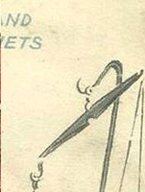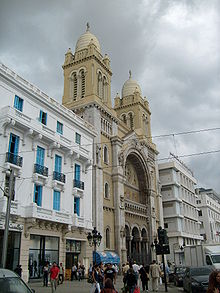Craving a sweet break or a snack for the four hours of your friends, that is irresistible “italo-tunisiens donuts” that can garnish. This pastry dough is very sticky and the ideal is to knead it by hand for better control by sprinkling a small veil of flour each time.
Ingredients
750 grams of flour
250 grams of semolina
A baking yeast cube
Salt
Oil
A plate of powdered sugar
A full oil Fryer |
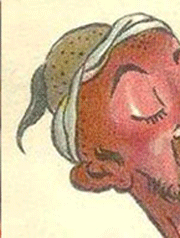 |
Preparation
In a large bowl, place the cornmeal and flour sifted.
Make a well in the centre.
Add the salt and yeast dissolved in 3 tablespoons of warm water.
Water gradually warm water working. Pick up the dough into a ball and knead it vigorously with both hands, crushing until fairly soft dough is obtained.
Continue to work energetically, sprinkling the dough from time to time with warm water, until it becomes very soft and elastic.
Moisten your hands with water, take the dough with both hands, lift it up and discard suddenly dry in glass bowl wooden.
Repeat several times so that the dough is light and malleable. Place the dough in a large pot water soaked.
Cover with a clean cloth and let rise in a warm place for 4 or 5 hours. The dough should double in volume. |
Tunis ( Arabic: تونس Tūnis) is the capital of both the Tunisian Republic and the Tunis Governorate. It is Tunisia's largest city, with a population of 2,256,320 as of 2011; the greater metropolitan area holds some 2,412,500 inhabitants. Etymology:Tunis is the transcription of the Arabic name which can be pronounced as "Tūnus", "Tūnas", or "Tūnis". All three variations were mentioned by the Greek-Syrian geographer al-Rumi Yaqout in his Mu'jam al-Bûldan (Dictionary of Countries). Different explanations exist for the origin of the name Tunis. Some scholars relate it to the Phoenician goddess Tanith ('Tanit or Tanut), as many ancient cities were named after patron deities. Some scholars claim that it originated from Tynes, which was mentioned by Diodoros and Polybius in the course of descriptions resembling present-day Al-Kasba; one of Tunis's suburbs.
During World War II, Tunis was held by Axis forces from November 1942 to May 1943. It was their last base in Africa, as they escaped to Italy after being surrounded by Allied forces from Algeria in the west and from Libya in the east..On 7 May 1943, at 15:30 in the afternoon, Tunis fell to troops and tanks of British 1st army who had defeated most of the German Fifth Panzer Army left guarding the city. At midday on 20 May 1943, the Allies held a victory parade on Avenue Maréchal Galliéni and Avenue Jules Ferry to signal the end of fighting in North Africa.Having succeeded in driving the Axis powers out of Tunisia, the Allies used Tunis as a base of operations to stage assaults against the island of Pantelleria, then Sicily, and finally Italy.
Following the Second World War, suburbs grew up quickly around Tunis to facilitate rapid industrialization.
The Great Synagogue of Tunis (تونس كنيس) is the main synagogue of Tunis, the capital of Tunisia - Facade of the great synagogue of Tunis with the Tetragrammaton YHWH in the star of David.
It is located on number 36 of the avenue de la Liberté in the centre of Tunis, in the Lafayette area, not far from the metro station "Republic" and of the Habib Thameur Garden on the site of the former Jewish cemetery. Work in June 1933, she is open in December 1938. During the occupation of Tunisia by the axis forces, from November 1942 to March 1943, the building is invested by from German soldiers arrest the leaders of the Community. In 1967, in the context of the Six-day war, he is sacked by the emeutiers. Restored in 1996 and then in 2007, on intervention by president Zine el-Abidine Ben Ali, it is guarded by municipal police and is sometimes open to the visiteurs although the celebrations are rare.
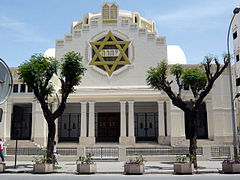
In 1971, the Israeli post issued a stamp with the effigy of the synagogue but, due to the Tetragrammatons' YHWH in the pediment of the building, the Rabbinate gets its withdrawal by condemning its use laic. The construction of a replica of the synagogue has also been considered in Netanya in Israel.
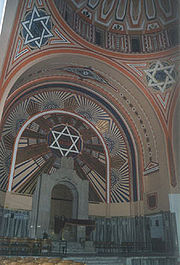
The initiative of its construction, intended to replace the synagogue in the Jewish quarter of the Hara, returns to the baron Giacomo Di Castelnuovo.
The Cathedral of St Vincent de Paul is a Roman Catholic cathedral in Tunis. Dedicated to Saint Vincent de Paul, patron saint of charity, the cathedral is the see of the Archdiocese of Tunis. It is situated in the Place de l'Indépendence in the Ville Nouvelle, a crossroads between Avenue Habib Bourguiba and Avenue de France, opposite the French embassy.
The church was built in a mixture of styles, including Moorish revival, Gothic revival, and Neo-Byzantine. Construction began in 1893 and the church was opened at Christmas 1897, albeit with temporary wooden belltowers owing to a shortage of funds.
Read more, refer to
Wikipedia.com
Harissa.com
JewishVirtual Library.org
Cardinal Charles Lavigerie had laid the first stone for a church on 7 November 1881 a little further down Avenue de la Marine (now Avenue Habib Bourguiba). This was a Pro-cathedral; the Catholic cathedral for Tunisia at that time being St Louis Cathedral, see of the Episcopal see of Carthage.The Pro-cathedral was built quickly, but its condition soon deteriorated due to the adverse ground conditions, necessitating the construction of the current cathedral.
The number of Roman Catholics in Tunisia fell rapidly following Tunisian independence from France. A modus vivendi reached between the Republic of Tunisia and the Vatican in 1964 resulted in the transfer of selected buildings to the Tunisian state for public use, including the Saint Louis Cathedral in Carthage. However, the Cathedral of St. Vincent de Paul remains under the ownership and operation of the Roman Catholic Church in Tunisia.
|


